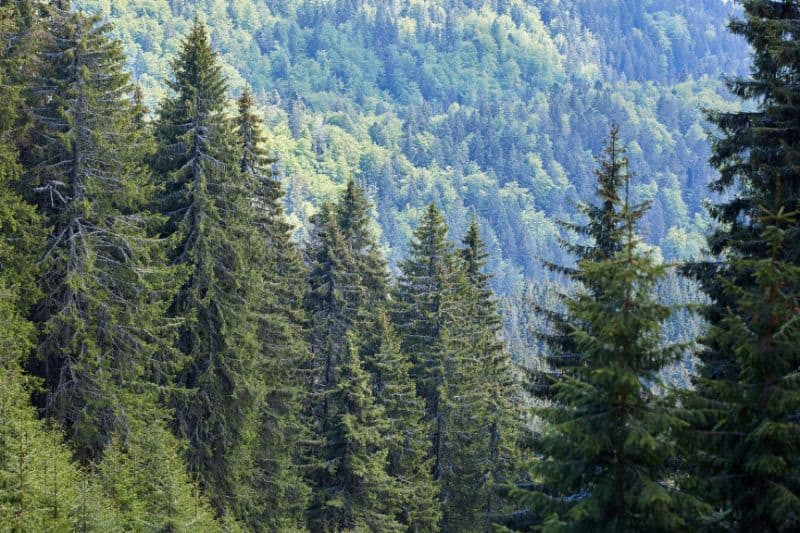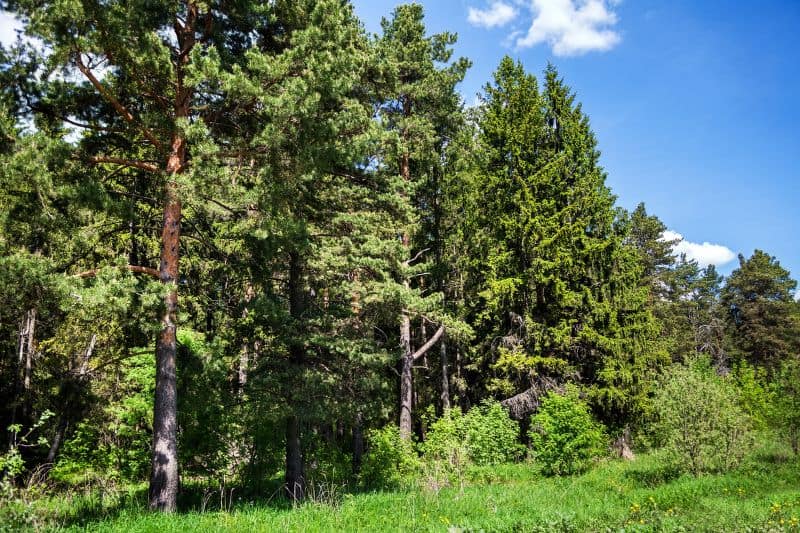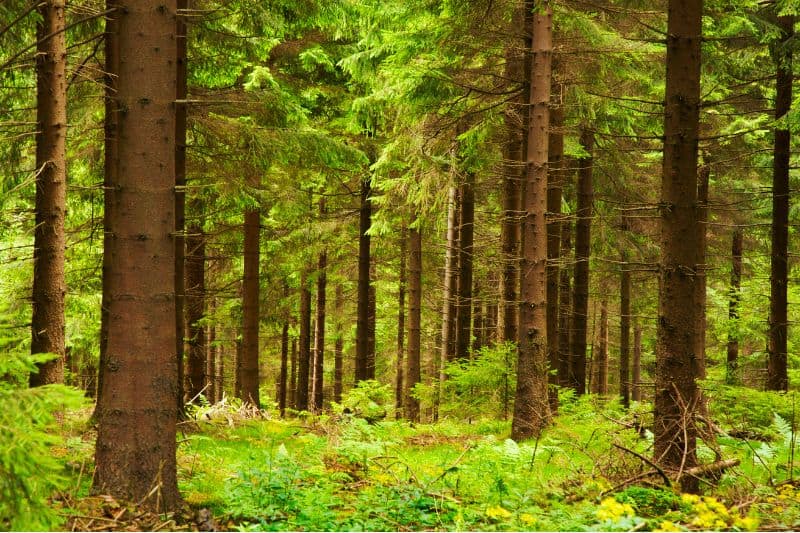Throughout the world, variations of flora, fauna, and environment create biomes – the word that describes a given area’s particular natural characteristics.
While there are several types of biomes in the world, ranging from deserts to frozen tundra, the coniferous forest is a type of biome that is seen all over the globe. These biomes are predominantly made up of – you guessed it – coniferous trees, which are so-called because their seeds take the form of cones.
Coniferous forests are mostly found in regions of the Earth that experience long winters and short summers. Coniferous forests are found mainly in the northern hemisphere, although some can still be found in the southern hemisphere.
Coniferous forests (fir, pine, spruce) make up around one-third of the world’s forests and are found in northern parts of North America, Europe, and Asia, where temperatures tend to be lower and winter tends to last longer. Ever wonder what a pinecone really is? Pine trees are some of the best-known conifers, and pinecones are their way of spreading seeds.
Most of the trees in coniferous forests are conifers (or evergreens), which are the toughest and longest-living trees in the world. They have needle-like leaves with a waxy outer coat to minimize water loss in freezing weather. Their branches are soft, flexible, and pointed downwards, so snow slides off them.
Climate
Because coniferous forests exist in a range of regions around the world, their climates depend on their location.
- Temperate coniferous forests are found in areas with temperate weather: plenty of rainfall, cool winters, and warm summers.
- Tropical and subtropical coniferous forests are found in areas with tropical latitudes, making their climates more humid.
- The boreal forest (Taiga) is a forest biome that spans from Siberia to Canada and has extremely cold winters, with summers ranging from mild to extremely hot.
The coniferous forest climate may differ slightly depending on the forest’s location around the world. Coniferous rainforest biomes stretch from Siberia to Canada and experience freezing winters and mild to hot summers.
Coniferous forests have really low temperatures throughout the year. The average temperature in winter is -54°C to -1°C, while the temperatures in summer are -7°C to 21°C. There are usually long, cold, mild, and wet summers in this region.
The biome’s winters are generally in the months of December, January, and February and are very cold and snowy. During winter, chilly winds from the Arctic cause extreme cold weather in the coniferous forest. The precipitation levels are quite low during winter.
Coniferous forests have warm, humid summers. During the months of June, July, and August, the temperature is at its highest, and there is also quite a lot of rainfall. These two factors contribute to the summer’s humid weather.
The length of the day mostly varies on the season. Summer days are shorter because of the tilt of the earth on its axis, while winters are longer (up to 6 months with mean temperatures below freezing).
Coniferous forests thrive in tropical and subtropical climates (areas with tropical latitudes). This makes the area’s climate more humid. During winter months, precipitation falls as snow, while in the summer, it falls as rain.
Fall is the shortest season for Taiga. Precipitation is high compared to the other biomes since a lot of snow falls in the winter and rain in the summer. The yearly precipitation is 10-30 inches (25-75 cm.) The average humidity is high in summer, from 50% to 80%, and the air is much drier in the winter.
Fires are common in taiga during summer, even though they might seem destructive. In this biome, they help by removing old, sick trees and making room for the new.
Location
Coniferous forests are found worldwide, from tropical islands to Switzerland. Some examples are:
Temperate regions
- The Alps: Austria, France, Italy, Switzerland, Germany, Slovenia
- Caledon: United Kingdom
- Carpathian: Czech Republic, Poland, Romania, Ukraine, Slovakia
- Altai Montane: China, Kazakhstan, Mongolia, Russia
- Da Hinggan-Dzhagdy: China and Russia
- East Afghan: Afghanistan, Pakistan
- Elburz Range: Iran
- Hokkaido: Japan
- Mediterranean: Algeria, Morocco, Tunisia
- Scandinavian: Norway, Finland, Sweden
- Himalayan: India, Nepal, Pakistan, Bhutan
- Coastal regions of the United States
- Canada
Tropical Regions
- Luzon: Philippines
- Sumatran: Indonesia
- The Bahamas
- Central American: Belize, Guatemala, Honduras, El Salvador, Mexico, Nicaragua
- Cuba
- Hispaniolan: Haiti, Dominican Republic
- Bermuda
Temperature
Temperatures vary based on the location of the forest but typically fall into these categories dependent on climate:
- Temperate: These areas have moderate temperatures but experience seasonal changes. Depending on location, some temperate areas may have overall colder temperatures – such as parts of Russia – or greater amounts of rainfall – such as London.
- Tropical: Found in tropical locations with a warm and humid climate. Temperatures are hot, with the requirement being that the average temperature year-round is 18 °C (64 °F) or higher.
- Boreal: The temperature changes in the boreal coniferous forests are by far the most extreme, with winters averaging -54° to -1°C (-65° to 30°F) and summers -7° to 21°C (20° to 70°F), although both seasons can experience far colder or hotter temperatures any given year.
Precipitation
As with any forest or environment that grows plants, water is a basic requirement. Levels of precipitation will be different from region to region, but all coniferous forests require enough rainfall to sustain and promote tree growth.
- Temperate: Precipitation amounts will range based on location. Typical average amounts are about 300-900 mm (12-35 in.), but some areas can see as much as 2,000 mm (78 in.) of rain yearly.
- Tropical: With higher humidity amounts, there is typically more overall precipitation in a tropical area. Some areas have “wet seasons,” which is when rainfall exceeds 60 mm (2.4 in) or more in a month.
- Boreal: Due to the extreme cold temperatures in the winter, these areas typically see most of their rainfall in the summer, with amounts ranging from 300-800 mm (12-30 in) a year.

Plants of the Coniferous Forests
Being forests, these areas are principally defined by their trees, but there are many varieties of conifers, as well as several other plants that thrive alongside them. These forests are known as evergreen coniferous forests, consisting of trees equipped with needles-like leaves.
Coniferous trees can protect themselves from cold and extreme climates due to the presence of thick bark. They are cone in shape and have very flexible branches that help them manage and survive even in heavy rainfall and let the snow slip down. The leaves, which are in the form of thin waxy needles, protect the plant from water loss.
The trees are evergreen in the sense that the leaves (needles) of these trees can make their food (photosynthesis) whenever sunlight is available to them. The dense forest protects the heat and makes the region warm in winter. The pine is one of the toughest covering found in plants that protect the seeds during the harsh and cold winters.
Trees
- Black spruce: Named for its dark-colored leaves and trunk, this tree is common in parts of North America and the boreal forest.
- White spruce: It looks much like the black spruce but with light leaves and trunk.
- Larch: These trees are small but incredibly durable, and varieties can be found in the coldest parts of the boreal forest.
- Lodgepole pine: Found in North America, particularly around the Pacific Northwest. It was named so because Native Americans used it to support “lodges.”
- Jack Pine: Often found on hillsides and other terrain that isn’t flat
- Balsam fir: found in North America and best known for being used as a Christmas tree
- Eastern white pine: These trees can grow very old and are found in North America.
- Bunya pine: A big tree found in Australia, and its wood is used for a variety of purposes.
- Yew: Found in parts of Europe and Asia, they can grow to be thousands of years old and are poisonous.
- Engelmann spruce: Found in North America, particularly around Colorado
- Douglas-fir: These trees grow incredibly large – both in height and width.
- Red cedar: This tree is found in different locations all over the world, typically more like a bush.
- Hemlock: This tree – not the plant – is found in cold regions in parts of Asia and North America.
- Redwoods: These are huge trees that grow in parts of California and the Pacific Northwest
- Giant sequoia: These make some of the world’s largest and oldest trees
- Siberian pines: They are hardy trees that can live long and grow slowly.
- Parana pine: It is found in South America, particularly on hillsides. It is slow-growing and found in high elevations.
- Kauri pine: A conifer found in New Zealand, recently protected due to overharvesting.
Other Plants
- Saskatoon berry: Shrub found in North American forests that produces edible berries and flowers in the spring.
- Thimbleberry: A common pant in coniferous forests producing small edible fruit, commonly seen on trails.
- Salal: Thick-growing shrub with edible berries in the Pacific Northwest
- Beaked hazelnut: The wild form of hazelnut that grows in the Pacific Northwest
- Nootka rose: Forests in Northwest America and parts of Canada see these lovely flowers
- Pitcher plant: A “carnivorous” plant that eats insects for nutrients as an adaptation around the lack of light due to tree cover.
- Sword ferns: Named for the “teeth” on their long leaves.
- Licorice ferns: Found growing in the trees as opposed to the ground
- Deer ferns: Plentiful on many forest floors.
- Mycorrhizae fungi: Typical of coniferous forests, these will typically live around the roots of conifers and are helpful for maximizing the amount of nutrients in the soil.
- Slippery jack fungus: Shaped like a toadstool, it is named because of the slippery substance that coats its cap.
- Reindeer moss: a very common lichen
- Plume moss: This dense covering moss is so-called because it looks like the plume of an ostrich. It is very helpful in breaking down rotten wood.

Animals of the Coniferous Forests
Coniferous forests provide habitat for many different animals. Depending on location, animal species and amounts will vary, but most coniferous forests are home to creatures from tiny microbes to large bears.
There are various factors depending on which only a few specific types of animals can live in the Coniferous forest biome. For example, food is quite scarce within the forests due to the harsh climate, and many of the inhabitants are omnivores and can adapt to food shortages.
Most coniferous plants are acidic; therefore, plant-eaters must be able to digest acids. The biome’s harsh climate and very low temperatures mean that there are many hibernating animals, and the majority of its inhabitants are warm-blooded animals.
All animals living in the biome have adaptations that allow them to withstand the cold weather, for example, thick fur coats and the ability to hibernate or migrate.
- Nematodes: These are tiny organisms that live in soil and are responsible for decomposing dead organic matter.
- Mosquitoes: They are found just about anywhere there is stagnant water, mosquitoes are seen in tropical forests and the boreal forest
- Engelmann spruce bark beetles: named because they love the bark of this spruce, these beetles can be incredibly destructive to these trees
- Moths and caterpillars: These two are typical of any forest region, and certain varieties can be harmful when in the caterpillar stage, as they feed off valuable new growth or harm branch development.
- Amphibians: Frogs, toads, and salamanders can be found in warmer forests, particularly in moist areas
- Canada geese: While they migrate in the colder parts of the year, these birds are found all over North American forests.
- Crossbill: This is a bird that has a beak designed specifically to be able to eat the cone seeds of conifers.
- Rodents: Mice, squirrels, and chipmunks are common in forest areas, both for the abundance of food available and for ample protection.
- Bears: Seen in forests, they hibernate over the winter to survive dropping temperatures and less available food. Grizzly bears and black bears are some coniferous dwellers.
- Beavers: Once much more common in forests, they were overhunted, leading to severe population declines.
- Wolverines: basically no more than large weasels, these fierce creatures are found in forests in North America, Europe, and Asia
- Chamois: It’s similar to a goat and found in mountainous forests in Europe.






